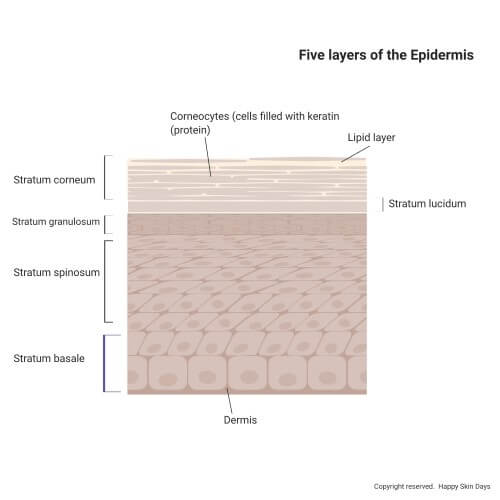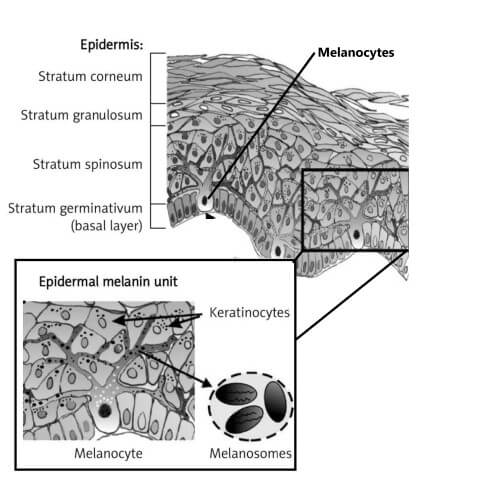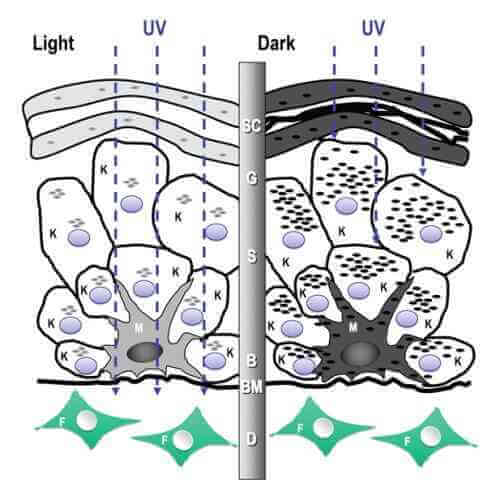****** THIS IS YOUR OFFICIAL GEEK ALERT. IF YOU ARE NOT INTO SCIENCE BECAUSE (e.g.) YOU THINK TRUMP IS A ROCKSTAR, STOP READING NOW. READ ROE v. WADE instead********
In this blog, I’ll first, explain what melanin is and how (eumelanin) determines our skin colour. Secondly, I’m going to focus on the photo-protective effect of melanin.
Why?
The purpose of all skin lightening or brightening or whitening products is to reduce the amount of melanin in our skin.
Melanin pigments: Eumelanin and Pheomelanin
Two pertinent skin pigments are Eumelanin (darker brown) and Pheomelanin (red-yellow). Pheomelanin does not really contribute to skin colour, as similar amounts of this pigment are observed in the dark and light skin. Darker-skinned individuals have more Eumelanin. And (unsurprisingly) it is the ratio of Eumelanin to total melanin that is one of the most significant factors that determines skin colour. (per Slominski A et al 2004)
Eumelanin has greater photoprotective ability and can scavenge and quench Reactive Oxygen Species. Pheomelanin does not have this property and can be a source of free radicals when the skin is irradiated with UVR. One of the consequences of this disparity in skin pigment is that the risk of skin-cancer in lighter skin is 30-40 fold higher than in darker skin. (Del Marmol V et al 1996)
The most important factor determining skin colour / the amount of skin pigment that your body produces is your GENES.
Secondly, its exposure to UV radiation.
____
Where is melanin produced in the skin?
Our skin is made of multiple layer – the topmost layers being the Epidermis, comprising of 5 layers. The most abundant cells found in the Epidermis are keratinocytes, which contain the most MELANIN. As keratinocytes push their way to the surface of the skin they accumulate more melanin. But the site of melanin production is the second most abundant type of cells, MELANOCYTES. Within melanocytes, melanin is synthesised within MELANOSOMES.

Epidermal melanin unit
Melanocytes are found in the Epidermis and the layer below it, the Dermis. These cells through dendritic extensions are in close contact with as many as 35-40 neighbouring keratinocytes in what is called the “Epidermal Melanin Unit.”

Source: Skin melanocytes: biology and developmentHow does melanin get from the Melanocyte to the Keratinocyte?
Melanin is transferred to adjacent melanocytes via the dendrites.
What does this have to do with skin complexion?
Skin complexion and in fact, sensitivity to UV radiation is determined by the AMOUNT and TYPE OF MELANIN in skin.
The difference between lightly and darkly pigmented individuals is NOT due to the NUMBER of melanocytes: both light and dark skinned individuals, broadly have similar number of Melanocytes.
The difference arises through (e.g.), the type of melanin produced; activity in the melanocytes; number of melanosomes and how much melanin they contain.
People with darker skin are consequently genetically programmed to constantly produce higher levels of Eumelanin and if you compare, lighter and darker skin you can see this

Source: The Protective Role of Melanin Against UV Damage in Human Skin (see below)In this diagram, you can see that there are more shaded oval shapes in the dark vs light skin – this is simply more Eumelanin. Apart from this, pretty much both skin types are the same.
Brenner M et al have indicated that the total melanin content in the Epidermis differs by 2x in Asian and Fair skinned individuals. Dark skinned individuals contain higher levels of Melanin (3x – 6x as much), more Eumelanin and larger Melanosomes.
Photoprotective nature of melanin
The short version is that Eumelanin is quite efficient at blocking UV radiation. Fairer skinned individuals have less Eumelanin than darker-skinned individuals and their skin is more permeable to UV radiation: they realize more UV radiation and are at risk of skin cancer.
The levels of Pheomelanin are pretty much the same in dark and light skinned individuals. In the fact in the presence of excessive UV radiation, Pheomelanin appears to increase its Reactive Oxygen Species function, thus being bad for the skin…
Dark skin and more Eumelanin means??
The greater amounts of Eumelanin in darker skin gives better protection against UV than fair skin.
Gloster and Neal indicate that Black skin (Fitzpatrick Skin Type VI) is twice as effective as compared to white skin in inhibiting UVB from penetrating the skin.
Black skin allows about 7.4% of UVB and 18% of UVA to penetrate BUT 24% of UVB and 55% of UVA passes through fairer skin.
Fitzpatrick scale
In the 1970s, Thomas Fitzpatrick defined skin phototype definitions based on the first 30-45 minutes of sun exposure after a winter season of no sun exposure.

Clearly this is such a crude scale, but everyone from scientists testing ingredients to manufacturers measuring SPF to regulators use this scale…
Now that I have laid some groundwork for skin colour, my next blog will be on How Melanin in our skin is produced.
Sources and uses
Gloster, H.M., Jr amd K. Neal (2006) Skin cancer in skin of color. J. Am. Acad. Dermatol. 55, 741-760
Michaela Brenner and Vincent J. Hearing, The Protective Role of Melanin Against UV Damage in Human Skin Photochemistry and Photobiology, 2008, 84: 539–549
Slominski A, Tobin DJ, Shibahara S, et al. Melanin pigmentation in mammalian skin and its hormonal regulation. Physiol Rev 2004; 84: 1155-228.
Del Marmol V, Beerman F. Tyrosinase and related proteins in mammalian pigmentation. FEBS Lett 1996; 381: 165-8.
